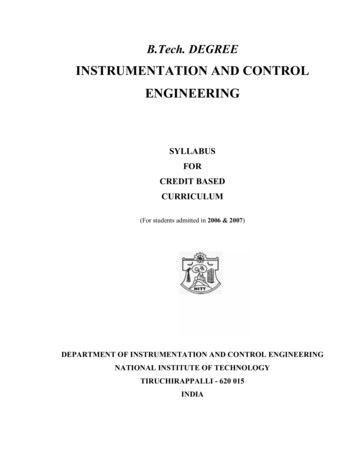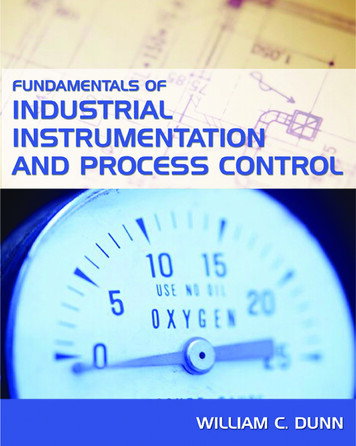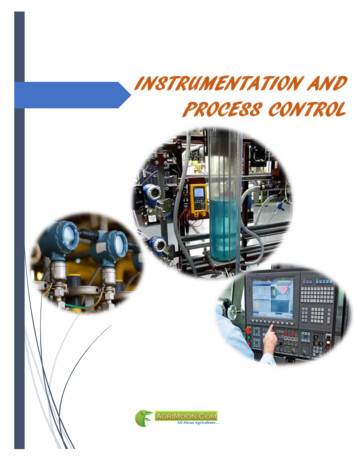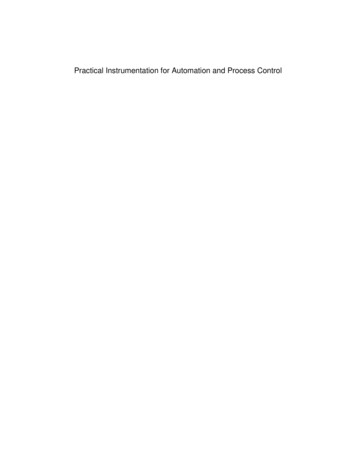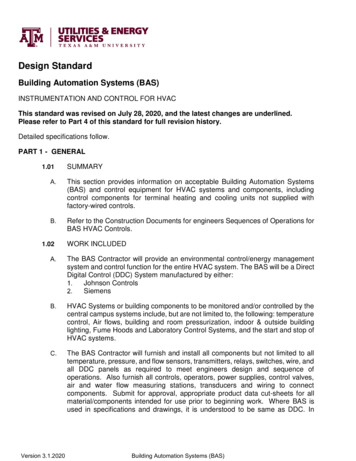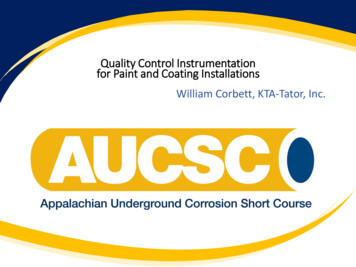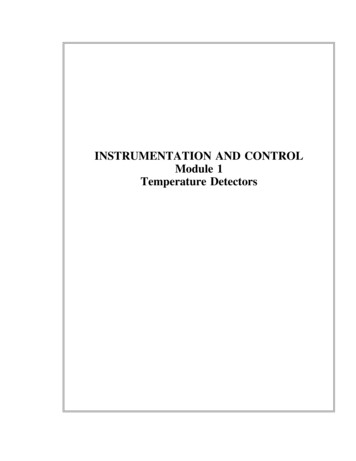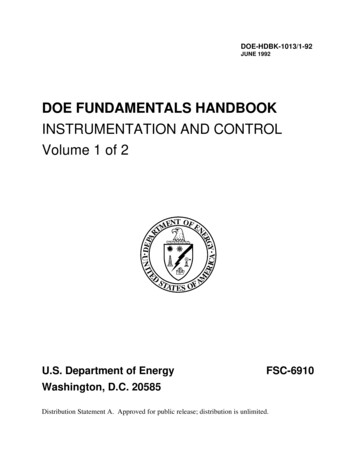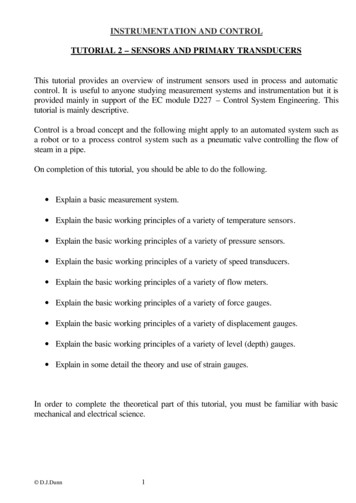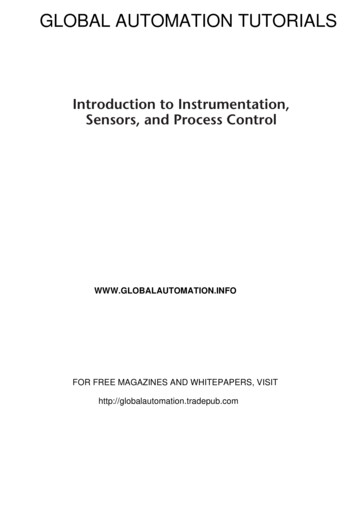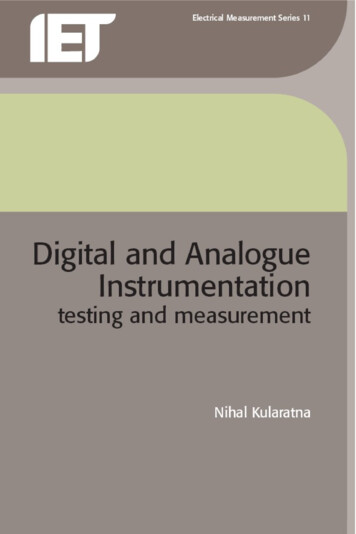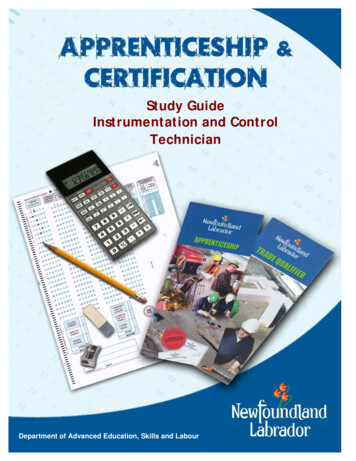
Transcription
Study GuideInstrumentation and ControlTechnicianDepartment of Advanced Education, Skills and Labour
Apprenticeship and CertificationStudy GuideInstrumentation and Control Technician(Based on 2013 NOA)Government of Newfoundland and LabradorDepartment of Advanced Education, Skills and LabourApprenticeship and Trades Certification DivisionVersion 7March 2019
Table of ContentsIntroduction . 3Exam Process . 4Before the Exam. 4During the Exam. 4After the Exam . 4Exam Format . 5Exam Content . 9Understanding the National Occupational Analysis (NOA) . 9Exam Breakdown . 11NOA Sub-tasks. 12Task Profile Checklist . 13Create a Study Plan . 189Resources - Websites . 21Resources – Book List. 22Resources – Book List (Continued) . 23Conclusion . 24AppendicesAppendix A:Regional Offices . 25Appendix B:Calculator Use . 26Appendix C:Answer Sheet Example . 27
IntroductionThis Study Guide has been developed by the Newfoundland and Labrador Department ofAdvanced Education, Skills and Labour, Apprenticeship and Trades Certification Division, toassist apprentices and trade qualifiers as they prepare to write the Interprovincial (IP) Red SealExam. IP Exams are available for all Red Seal trades. For a list of Interprovincial trades pleaserefer to the Department of Advanced Education, Skills and Labour website:www.ed.gov.nl.ca/app/trades.htmlSome of the specific goals of this guide are: to help you understand the skills and knowledge that might be covered on the exam to help you identify your strengths and weaknesses to provide organization and structure for a course of study to provide a list of resources to help you with your study plan to support and supplement the teaching and learning processThis study guide outlines the theoretical portion of the program. The intent is not to replacetechnical training provided under the guidance of instructors. Rather, it is a tool to be used inconjunction with formal training.Study Guide InstrumentationAndControlTechnician 20193
Exam ProcessBefore the ExamYou must contact the nearest Apprenticeship and Trades Certification Divisional office to makerequest to write the IP Red Seal exam (See Appendix A for a list of regional offices). Uponapproval, the Apprenticeship Program Officer (APO) will notify you of your eligibility to writethe exam, and provide you with scheduling information. If you require special accommodationsdue to a disability or language barrier, please contact your regional office for information onapplying for this service.During the ExamYou must bring: personal identification such as a photo or signature ID or valid Newfoundlandand Labrador driver’s license your notification letterThe following will be provided: a calculator (see Appendix B for calculator information) all other items required such as pencils, scrap paper, etc.Important Note:Personal cell phones, calculators, or other electronic equipment are NOT allowed into theexam room. If you do bring them, they will be stored away and returned to you when youhave completed the exam.After the ExamResults will be mailed to you approximately seven to ten days after completion of the exam. Allnecessary instructions and information will be provided in the results letter.The percentage mark you obtained will be provided. You will also be given a section by sectionbreakdown, showing how many questions were in each section, as well as the number ofquestions in each section you completed successfully.If you are successful in obtaining a 70% or more on your exam, you will be issued aNewfoundland and Labrador Certificate of Qualification with a Red Seal endorsement.4Study Guide InstrumentationAndControlTechnician 2019
Exam FormatAll IP Red Seal exams are written in multiple choice format. Each exam has between 100 and150 questions. A multiple choice question consists of a stem (a complete question) followed byfour options (A, B, C, D). The stem contains all the information necessary to answer thequestion. The options consist of the one correct answer and three “distracters.” Distractersare incorrect. (See Appendix C for a sample answer sheet).IP Red Seal exams contain three types of questions:Level 1Knowledge and RecallLevel 2Procedural and ApplicationLevel 3Critical ThinkingQuestions at this level test your ability to recall and understand definitions, facts,and principles.Questions at this level test your ability to apply your knowledge of procedures toa new situation.Questions at this level test your ability to interpret data, solve problems andarrive at valid conclusions.Level 1 Examples:1. When selecting a replacement component, which factor ensures that aconveyor electronic weigh scale will function properly?A.B.C.D.Maximum length of belt.Minimum width of belt.Average speed of belt.Sensor specifications.Study Guide InstrumentationAndControlTechnician 20195
2. Upon which principle of operation is a bulls-eye level gauge used on asteam boiler service based?A. Conductivity of water.B. Voltage change of thermocouple.C. Differing refractive indexes of steam andwater.D. Resistance change of a resistance temperaturedetector.3. Where is an intrinsic safety barrier panel installed?A. In a hazardous area with the ground bus barsreturned to plant ground.B. In a safe area with no grounds.C. In a hazardous area with no grounds.D. In a safe area with an isolated ground.Level 2 Examples:1. When removing a 129 V DC explosion-proof instrument from service,which procedure would ensure equipment and personal safety?A. Lockout and tag, inform operations, openbreaker, isolate from process.B. Lockout and tag, isolate from process, openbreaker, inform operations.C. Inform operations, lockout and tag, openbreaker, isolate from process.D. Inform operations, isolate from process, openbreaker, lockout and tag.6Study Guide InstrumentationAndControlTechnician 2019
2. While calibrating a variable speed drive, 10% input equals 15% speed, 50%input equals 55% speed and 90% input equals 95% speed. What type oferror is . Which types of transducers can be used to measure displacement ormotion?A.B.C.D.LVDTs, piezoelectric, and variable resistance.LVDTs, variable resistance, and thermoelectric.Variable resistance, and thermoelectric.Thermoelectric, LVDTs, and sonic.Level 3 Examples:1. When installing a control valve on a steam process, which of the followingvalve ratings could be used? The process pressure is 1000 psi and 250 C.A.B.C.D.Valve rating 2000 psi, 100 C.Valve rating 500 psi, 500 C.Valve rating 1000 psi, 500 C.Valve rating 1000 psi, 150 C.Study Guide InstrumentationAndControlTechnician 20197
2. After replacing the speed-sensing probe, what is the probable cause of a60 Hz reading being detected on the output signal of an induction-typespeed sensor?A.B.C.D.The polarity is reversed.The terminals are corroded.The sensor is out of alignment.The shielding has not been properly grounded.3. A nuclear density meter on an oil pipeline is showing erratic output. Whatis the probable fault?A.B.C.D.The scintillation counter is defective.The source has decayed.The shutter has been left practically closed.The source beam path is permanentlyobstructed.Source of 4ns-eng.html?tid 1308Study Guide InstrumentationAndControlTechnician 2019
Exam ContentUnderstanding the National Occupational Analysis (NOA)The NOA is a document used for Red Seal trades that describes the knowledge, skills andabilities required by a fully competent tradesperson working in that trade. The content for theIP Red Seal exam is based on the NOA. The NOA is an excellent tool to use as you study for theRed Seal exam. NOAs can be found at www.red-seal.ca.NOA material is organized into major content areas called BLOCKS. The blocks are furtherbroken down into TASKS and SUB-TASKS.NOABlocksBlocksStudy Guide InstrumentationAndControlTechnician 2019 Tasks Sub-tasks9
NOA Pie ChartThe NOA Pie Chart presents the block percentages in the form of a pie chart which tells you theapproximate number of questions from each block. For example, 6% of the questions on theInstrumentation and Control Technician Exam will be based on Block A.Instrumentation and Control TechnicianBlock ABlock BBlock CBlock D10Block TitlesCommon Occupational SkillsBlock E Final Control DevicesProcess Measuring and IndicatingBlock F Communication Systems and DevicesDevicesSafety and Security Systems andBlock G Control Systems and Process ControlDevicesHydraulic, Pneumatic and ElectricalSystemsStudy Guide InstrumentationAndControlTechnician 2019
Exam BreakdownThe Instrumentation and Control Technician exam currently has 125 questions. The followingtable shows a breakdown of the number of questions that come from each NOA block. It isimportant to note that the exact number of questions can change at any time. When you areready to write your exam, you may contact your regional office to verify the number ofquestions (See Appendix A).# of QuestionsBlock ACommon Occupational SkillsTask 1Performs safety-related functionsTask 2Organizes workTask 3Performs routine trade activitiesBlock B7Process Measuring and Indicating DevicesTask 4Installs and services pressure, temperature, level and flow devicesTask 5Installs and services motion, speed, position and vibration devicesTask 6Installs and services mass, density and consistency devicesTask 7Installs and services process analyzersTask 8Installs and services multiple variable computing devicesBlock CSafety and Security Systems and DevicesTask 9Installs and services safety systems and devicesTask 10Installs and services facility security systems. (NOT COMMON CORE)Task 11Installs and services safety instrumented systems (SISs)Block DHydraulic, Pneumatic and Electrical SystemsTask 12Installs and services control devices for hydraulic systemsTask 13Installs and services pneumatic equipmentTask 14Installs and services electrical and electronic equipmentBlock EFinal Control DevicesInstalls and services valvesTask 16Installs and services actuatorsTask 17Installs and services positionersTask 18Configures and services variable speed drives (VSDs)Communication Systems and Devices1014Task 19Installs and services control network systemsTask 20Installs and services signal convertersTask 21Installs and services gateways, bridges and media convertersBlock G924Task 15Block F35Control Systems and Process Control26Task 22Establishes and optimizes process control strategiesTask 23Installs and services stand-alone controllers (SACs)Task 24Installs and services programmable logic controllers (PLCs)Task 25Installs and services distributed control systems (DCSs)Task 26Installs and services human machine interfaces (HMIs)Task 27Installs and services supervisory control and data acquisition (SCADA) systemsTotalStudy Guide InstrumentationAndControlTechnician 201912511
NOA Sub-tasksThe following NOA Task Profile Checklist outlines the blocks, tasks and sub-tasks for your trade.The IP Red Seal exam is written to test your knowledge and abilities regarding the sub-tasks inthe NOA. This chart can be used to review your current knowledge. You can review by placinga checkmark ( ) next to those you understand fully.Place your focus on those you do not understand and study them until you are comfortablewith the material. Think of possible questions in that particular content area.The NOA also contains a list of “supporting knowledge and abilities” for each sub-task. Theyare the skills and knowledge you must have to perform a sub-task. The supporting knowledgeand abilities identified under each sub-task will be very helpful as you review. The list can befound in the NOA for your trade.12Study Guide InstrumentationAndControlTechnician 2019
Task Profile ChecklistBased on 2013 NOAInstrumentation and Control TechnicianBlock A: Common Occupational SkillsSub-Tasks Task 1: Maintains safe work environment. Uses personal protective equipment (PPE) and safety equipment Performs de-energizing, lock-out and tag-out procedures Task 2:Sub-TasksPerforms safety-related functionsOrganizes work Uses diagrams, drawings and schematics Plans tasks Task 3:Performs routine trade activitiesSub-Tasks Maintains calibration, configuration and test equipment Maintains tools Maintains documentation Operates material handling equipmentBlock B: Process Measuring and Indicating Devices Task 4:Installs and services pressure, temperature, level and flow devicesSub-Tasks Installs pressure, temperature, level and flow devices Maintains pressure, temperature, level and flow devices Diagnoses pressure, temperature, level and flow devices Repairs pressure, temperature, level and flow devicesSub-Tasks Task 5:Installs and services motion, speed, position and vibration devices Installs motion, speed, position and vibration devices Maintains motion, speed, position and vibration devices Diagnoses motion, speed, position and vibration devices Repairs motion, speed, position and vibration devicesStudy Guide InstrumentationAndControlTechnician 201913
Block B: Process Measuring and Indicating Devices (Cont’d) Task 6:Installs and services mass, density and consistency devicesSub Tasks Installs mass, density and consistency devices Maintains mass, density and consistency devices Diagnoses mass, density and consistency devices Repairs mass, density and consistency devices Task 7:Installs and services process analyzersSub-Tasks Installs process analyzers Maintains process analyzers Diagnoses process analyzers Repairs process analyzers Task 8:Installs and services multiple variable computing devicesSub-Tasks Installs multiple variable computing devices Maintains multiple variable computing devices Diagnoses multiple variable computing devices Repairs multiple variable computing devicesBlock C: Safety and Security Systems And DevicesSub-Tasks Task 9:Installs and services safety systems and devices Installs safety systems and devices Maintains safety systems and devices Diagnoses safety systems and devices Repairs safety systems and devices Task 10: Installs and services facility security systems. (NOT COMMON CORE)Sub-Tasks Installs facility security systems. (NOT COMMON CORE) Maintains facility security systems. (NOT COMMON CORE) Diagnoses facility security systems. (NOT COMMON CORE) Repairs facility security systems. (NOT COMMON CORE) Task 11: Installs and services safety instrumented systems (SISs)Sub-Tasks Installs SISs Configures SISs Maintains SISs Diagnoses SISs Repairs SISs14Study Guide InstrumentationAndControlTechnician 2019
Block D: Hydraulic, Pneumatic and Electrical Systems Task 12: Installs and services control devices for hydraulic equipmentSub-Tasks Installs control devices for hydraulic systems Maintains control devices for hydraulic systems Diagnoses control devices and hydraulic systems Repairs control devices for hydraulic systems Task 13: Installs and services pneumatic equipmentSub-Tasks Installs pneumatic equipment Maintains pneumatic equipment Diagnoses pneumatic equipment Repairs pneumatic equipment Task 14: Installs and services electrical and electronic equipmentSub-Tasks Installs electrical and electronic equipment Maintains electrical and electronic equipment Diagnoses electrical and electronic equipment Repairs electrical and electronic equipmentBlock E: Final Control Devices Task 15: Installs and services valvesSub-Tasks Installs valves Maintains valves Diagnoses valves Repairs valves Task 16: Installs and services actuatorsSub-Tasks Installs actuators Maintains actuators Diagnoses actuators Repairs actuatorsStudy Guide InstrumentationAndControlTechnician 201915
Block E: Final Control Devices (Cont’d) Task 17: Installs and services positionersSub-Tasks Installs positioners Maintains positioners Diagnoses positioners Repairs positioners Task 18: Configures and services variable speed drives (VSD)sSub-Tasks Configures VSDs Maintains VSDs Diagnoses VSDs Repairs VSDsBlock F: Communications Systems and DevicesSub-Tasks Task 19: Installs and services control network systems Performs installation and configuration on control network systems Diagnoses control network systems Performs maintenance and repairs on control network systemsSub-Tasks Task 20: Installs and services signal converters Performs installation and configuration of signal converters Diagnoses signal converters Performs maintenance and repairs on signal convertersSub-Tasks Task 21: Installs and services gateways, bridges and media converters Performs installation and configuration of gateways, bridges and media converters Diagnoses gateways, bridges and media converters Performs maintenance and repairs on gateways, bridges and media convertersBlock G: Control Systems and Process Control16Study Guide InstrumentationAndControlTechnician 2019
Sub-Tasks Task 22: Establishes and optimizes process control strategies Determines process control strategy Optimizes process controlSub-Tasks Task 23: Installs and services stand-alone controllers (SACs) Installs SACs Configures SACs Performs maintenance, diagnostics and repairs on SACsSub-Tasks Task 24: Installs and services programmable logic controllers (PLCs) Installs PLCs Configures PLCs Performs maintenance, diagnosis and repairs on PLCsSub-Tasks Task 25: Installs and services distributed control systems (DCSs) Installs DCSs Configures DCSs Performs maintenance, diagnosis and repairs on DCSsSub-Tasks Task 26: Installs and services human machine interfaces (HMIs) Installs HMIs Configures HMIs Performs maintenance, diagnosis and repairs on HMIsSub-Tasks Task 27: Installs and services supervisory control and data acquisition (SCADA) systems Installs SCADA systems Configures SCADA systems Performs maintenance, diagnosis and repairs on SCADA systemsStudy Guide InstrumentationAndControlTechnician 201917
Create a Study PlanAs you prepare for your exam, it is important to plan a schedule. The following two tables willhelp you stay on track.The first table is a “Weekly Study Plan.” In this table list the areas you will focus your studyfor each day. You should include items you need to review as well as items you need to study.Remember, more time will be needed for study in areas you find difficult, whereas you mayonly require review in areas you are more familiar with. As you work through the NOA subtask list you can start to fill in this table.The second table is a “Study Time Table.” It is important to create a study schedule whereyou determine the best days of the week and times of day for you to study.Print several copies of these tables and fill out for each week of study. It is important to stickto your study schedule.18Study Guide InstrumentationAndControlTechnician 2019
Weekly Study Plan for Week of:Area of Study 1Mon.Tues.Wed.Thu.Fri.Sat.Sun.Area of Study 2Area of Study 3Area of Study 4Area of Study 5Area of Study 6
Study Time Table for Week of:Monday8:00 AM 9:00 AM9:00 AM 10:00 AM10:00 AM 11:00 AM11:00 AM 12:00 Noon12:00 Noon1:00 PM1:00 PM 2:00 PM2:00 PM 3:00 PM3:00 PM 4:00 PM4:00 PM 5:00 PM5:00 PM 6:00 PM6:00 PM 7:00 PM7:00 PM 8:00 PMTuesdayWednesdayThursdayFridaySaturdaySunday
Resources - WebsitesStudy information can be drawn from a variety of sources. A sample list of study materials(websites and books) is provided below. These and other helpful resources may be found in alocal college bookstore, on the internet, or at your place of employment. You may also be ableto borrow them from an apprentice or journeyperson in your trade.Study Strategies and Exam Preparation GuideThe Study Strategies & Exam Preparation Guide is meant to be used in conjunction with this studyguide. It provides direction and information on such areas as study habits, test preparation and testtaking techniques.Exam Preparation Guide: www.aesl.gov.nl.ca/app/publications/exam prep guide.pdfPlan of Training (POT)A Provincial Plan of Training details the full scope of learning for a particular occupation, including bothtechnical training competencies and industry experiences necessary to write an IP Red Seal exam (andcomplete the requirements for Red Seal Certification), or to write a provincial examination. The Plan ofTraining is based on the NOA.POT Website: www.aesl.gov.nl.ca/app/plans.htmlRed Seal WebsiteNational Occupational Analysis - The NOA is a document used for Red Seal trades that describes theknowledge and abilities required by a fully competent tradesperson working in that trade. The contentfor the IP exam is based on the NOA.Red Seal Website: www.red-seal.caInstrumentation and Control Technician PRACTICE ExamThis is NOT an IP exam. This is a practice exam provided by the Inter-provincial Standards Red SealProgram. It was developed using similar question types to that of a Red Seal exam. The exam isintended to be used for self-assessment in preparation for writing an IP Exam.Practice Exam s-eng.html?tid 130Glossary of TermsThe Red Seal website also lists a Glossary of Terms which will be helpful in preparing for your 013n.4.1 .1ppb gl.4ss.1ry-eng.htmlStudy Guide InstrumentationAndControlTechnician 201921
Resources – Book ListThe books listed below are sorted according to NOA blocks as referenced throughout thisstudy guide. You can use this list to help you obtain information on specific topics. It is notnecessary to use these books specifically, as you may find others that will be equally beneficial.BOOKA BCProcess Measurement and Analysis Process Control and OptimizationMeasurement and Control BasicsthDelmar’s Standard Text of Electricity, 4 Ed.thInstrumentation, 4 Ed.D EFG Canadian Electrical Code CE Code Pocket Reference Hand Tools for Instrumentation – Module 12101-01 Power Tools for Instrumentation – Module 12103-01 Fasteners – Module 12103-01 Filters, Regulators, and Dryers – Module 12210-03Clean, Purge, and Test Tubing and Piping Systems –Module 12303-03Grounding and Shielding of Instrumentation Wiring –Module 12306-03Terminating Conductors – Module 12307-03Troubleshooting and Commissioning a Loop – Module12404-03Performing Loop Checks – Module 12403-03Tuning Loops – Module 12405-03Tubing – Module 12111-01 If you wish to obtain any of the resources listed above, here is the reference information: Delmar’s Standard Text of Electricity, 4th edition, Delmar Publishers, 2008, Herman, S., ISBN978-1418065805 Process Measurement and Analysis, Instrument Engineers’ Handbook, 4th Edition, 2003,Liptak, B.G., ISA. ISBN 0-8493-1083-0 Process Control and Optimization, Instrument Engineers’ Handbook, 4th Edition, 2006,Liptak, B.G., ISA. ISBN 0-8493-1081-4 Measurement and Control Basics, 4th Edition, 2007, Hughes, T.A., ISA. ISBN 978-1-55617916-7 Instrumentation, 4th Edition, 2005, ISBN 978-0-8269-3423-9 Instrumentation Workbook, 4th Edition, 2005. ISBN 978-0-8269-3424-6 Canadian Electrical Code, Part 1 (Safety Standard to Electrical Installations), 2009, CSA.ISBN 978-1-55436-473-222Study Guide InstrumentationAndControlTechnician 2019
Resources – Book List (Continued) CE Code Pocket Reference (Safety Standard for Electrical Installations), 2009, CSA. ISBN978-1-55491-046-5 Hand Tools for Instrumentation, Module 12101-01, 2001, NCCER (National Center forConstruction Education and Research Module). ISBN 0-13-868167-8 Power Tools for Instrumentation, Module 12103-01, 2001, NCCER (National Center forConstruction Education and Research Module). ISBN 0-13-868225-9 Fasteners, Module 12106-01, NCCER (National Center for Construction Education and ResearchModule). ISBN 0-13-868324-7 Filters, Regulators, and Dryers, Module 12210-03, 2001, NCCER (National Center forConstruction Education and Research Module). ISBN 0-13-103274-7 Clean, Purge, and Test Tubing and Piping Systems, Module 12303-03, 2001, NCCER (NationalCenter for Construction Education and Research Module). ISBN 0-13-103298-4 Grounding and Shielding of Instrumentation Wiring, Module 12306-03, 2001, NCCER (NationalCenter for Construction Education and Research Module). ISBN 0-13-103302-6 Terminating Conductors, Module 12307-03, 2001, NCCER (National Center for ConstructionEducation and Research Module). ISBN 0-13-103303-4 Troubleshooting and Commissioning a Loop, Module 12404-03, 2001, NCCER (National Centerfor Construction Education and Research Module). ISBN 0-13-109614-1 Performing Loop Checks, Module 12303-03, 2001, NCCER (National Center for ConstructionEducation and Research Module). ISBN 0-13-109613-3 Tuning Loops, Module 12405-03, 2001, NCCER (National Center for Construction Education andResearch Module). ISBN 0-13-109613-3 Tubing, Module 12111-01, 2001, NCCER (National Center for Construction Education andResearch Module).Study Guide InstrumentationAndControlTechnician 201923
DisclaimerVarious external resources (websites, textbooks) have been listed in this study guide to assist anindividual in preparing to write an IP Red Seal Exam. This does not mean the Department ofAdvanced Education, Skills and Labour, Newfoundland and Labrador endorses the material orthat these are recommended as the best resources. There may be other resources of equal orgreater value to an individual preparing for an IP Red Seal exam. The Department of AdvancedEducation, Skills and Labour has no control over the content of external textbooks and websiteslisted, and no responsibility is assumed for the accuracy of the material.ConclusionWe hope this guide has provided you with some useful tools as you prepare for your IP Red Sealexam. If you have any questions regarding your IP Red Seal exam please contact your regionaloffice (see Appendix A for a list of regional offices).We appreciate your comments and feedback regarding the usefulness of this study guide. Ifyou have any comments or suggestions, we welcome your feedback. The feedback form at theend of this guide can be used for this purpose.24Study Guide InstrumentationAndControlTechnician 2019
Appendix A: Regional OfficesIf you have any questions regarding your IP Red Seal exam, please contact one of the followingregional offices:Department of Advanced Education, Skills and LabourApprenticeship and Trades Certification DivisionToll Free: orner BrookGrand Falls-Windsor1-3 Union StreetAylward Building, 2nd FloorCorner Brook, NL A2H 5M742 Hardy AvenueGrand Falls-Windsor, NLA2A 2J9Telephone:Facsimile:Telephone:Facsimile:(709) 637-2366(709) 637-2519Clarenville(709) 292-4215(709) 292-4502St. John’s45 Tilley’s RoadClarenville, NLA5A 1Z4P.O. Box 87001170 Topsail RoadMount Pearl, NL A1B 4J6Telephone:Facsimile:Telephone:Facsimile:(709) 466-3982(709) 466-3987(709) 729-2729(709) 729-5878Happy Valley – Goose Bay163 Hamilton River RoadBursey BuildingHappy Valley – Goose Bay, NLA0P 1E0Telephone:Facsimile:(709) 896-6348(709) 896-3733Study Guide InstrumentationAndControlTechnician 201925
Appendix B:Calculator UseThe picture below shows a calculator with the same functions as the one you will be providedwith during your exam. It is advisable to borrow or purchase one with similar functions so thatyou can familiarize yourself with it before you write your exam.26Study Guide InstrumentationAndControlTechnician 2019
Appendix C:Answer Sheet ExampleWith your exam you will be given an answer sheet similar to the one below. When answeringmultiple choice questions be sure to fill the circle completely and fill the circle that correspondsto the question on the exam.Study Guide InstrumentationAndControlTechnician 201927
Feedback FormStudy Guide – Instrumentation and Control Technician
Instrumentation and Control Technician (Based on 2013 NOA) Government of Newfoundland and Labrador Department of Advanced Education, Skills and Labour Apprenticesh
